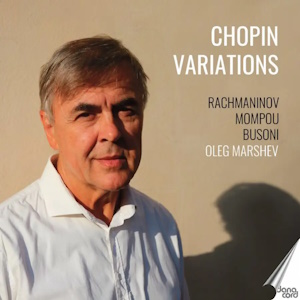
Commanding performances of three works in homage to Chopin
Chopin Variations
Sergei Rachmaninov (1873-1943)
Variations on a Theme of Chopin, op.22 (1902-1903)
Federico Mompou (1893-1987)
Variations sur un thème de Chopin (1938-1957)
Ferruccio Busoni (1866-1924)
Variations on a Prelude by Chopin, BV213a (1884/1922)
Oleg Marshev (piano)
rec. 2024, Cultural Institute, Milan, Italy
Danacord DACOCD984 [83]
First on the programme, we get Sergei Rachmaninov’s Variations on a Theme of Chopin. He began the composition in 1902 when he had returned to his estate in Ivanovka, Russia after a three-month honeymoon with Natalia Satina. During the long vacation, he had visited Venice, Lucerne and Vienna, and saw The Ring, The Flying Dutchman and Parsifal in Bayreuth. He completed the Variations in February 1903, the same year as the more popular Ten Preludes op.23.
The Variations are often analysed as a sonata form in three (my preference) or four movements. Each variation is part of this structural plan. The theme is Chopin’s Prelude op.28 No.20 in C minor, the “gloomiest and most funereal” of the set. The first ten Variations are short and rapid. The following eight are slow, except the brisk, dashing Allegro scherzando. The heart of the piece is Variation 16, with its yearning mood. The final “movement” consists of four variations, longer, faster and more developed than what has gone on before. The last one combines introspection with a final hectic race towards the end.
As can be imagined, these twenty-two variations explore a wide range of emotion. It has been said that Rachmaninov incorporated every pianistic trick that he knew. There are many passages of pyrotechnics, high romanticism and even “Bachian counterpoint” in Variation 12.
The Variations may become a little long-winded over its 35-minute duration, even a bit unbalanced. I guess the technique for best-practice performance must be to emphasise the overarching structure, and provide a stunning display of the Russian’s romantic brilliance. For me, Oleg Marshev achieves this desideratum.
Spanish composer and pianist Federico Mompou was known for his sophisticated piano music. He spent considerable time in Paris, where he gained recognition, but he eventually returned to his native Barcelona. His music, influenced by French impressionism and Catalan culture, often featured short, lyrical numbers that evoke a sense of quiet introspection.
Mompou’s Variations sur un thème de Chopin began in 1938 as a collaborative venture \with his friend, cellist Gaspar Cassadó. They aimed to create a set of variations for cello and piano based on Chopin’s Prelude op.28 No.7 in A major. The project was never fulfilled. In 1955, conductor John Lanchbery requested a score suitable for a ballet, prompting Mompou to revive and complete the variations. According to the liner notes, of the twelve variations, Nos.1, 2, 3 and 5 originated from the abandoned venture.
Compared to Rachmaninov’s set, Mompou’s work is “ethereal” and “other-worldly”, a subtle blend of impressionism and romanticism. He has paid homage to Chopin by using some of his best-loved musical forms: the mazurka (Variation 5), the valse (Variation 9) and a kind of Polonaiseh (Variation 12). I loved the suggestion in the liner notes: “in all these cases, the harmony slips between Chopin’s world and Mompou’s like a person who appears to be in two rooms at once, yet whose mind is always somewhere else.” There is a definite jazz influence in these pages, at least of the cocktail-piano variety. And then there are nods to the ‘big tune’ from the famous fantaisie-impromptu. Oleg Marshev gives a sense of cohesion throughout the variations, and emphasises the gentler elements of Mompou’s language. He creates a sense of intimacy and quiet reflection, but there is an almost Boogie-woogie vivacity in the Galop y Epilogo.
A few words about Ferruccio Busoni may be of interest. He was an Italian composer, pianist, conductor, editor, author and educator, known for his virtuosic piano performances and innovative works. His music often combined late-Romantic elements with more modernist ideas. His notable compositions include the opera Doktor Faust, the Fantasia contrappuntistica for solo piano, and numerous transcriptions of Johann Sebastian Bach’s music.
Busoni’s Variations on a Prelude by Chopin as played here are a bit of a mishmash. The liner notes refer to a “portmanteau” edition. Originally written in 1884, the work consisted of a theme based on Chopin’s C minor Prelude, eighteen variations and a concluding fugue. Busoni recomposed it in 1922, as he found the original unwieldy. It was cut down to ten variations. The booklet explains that Oleg Marshev has fused two versions: he plays the Introduction and Variation 1 from the 1922 score, followed by Variations 2-8 from 1884, before returning to the revision and playing through Variation 2 until the end.
This reorganisation may confuse the listeners unless they look at the sheet music. I followed the 1922 segment in the score, and it is a magnificent exercise in virtuosity. This is especially so in the finale, which is a Scherzo of considerable complexity and pace, into which Busoni interposed a delightful waltz in “Hommage à Chopin.” It is redundant to state that these Variations require technical prowess and a deep understanding of Chopin’s and Busoni’s musical languages. Oleg Marshev does provide that, but I do wish that he had settled on one of the editions.
The recording, vibrant and clear, is a perfect complement to the power and range of this music. Peter Quantrill’s liner notes give a good overview of the three pieces, and also details of Oleg Marshev’s career.
I enjoyed this disc, with the caveat about Busoni’s Variations. It allowed me to hear three works that honour Frédéric Chopin. Mompou’s and Busoni’s pieces are new to me. Oleg Marshev gives commanding performances throughout.
John France



